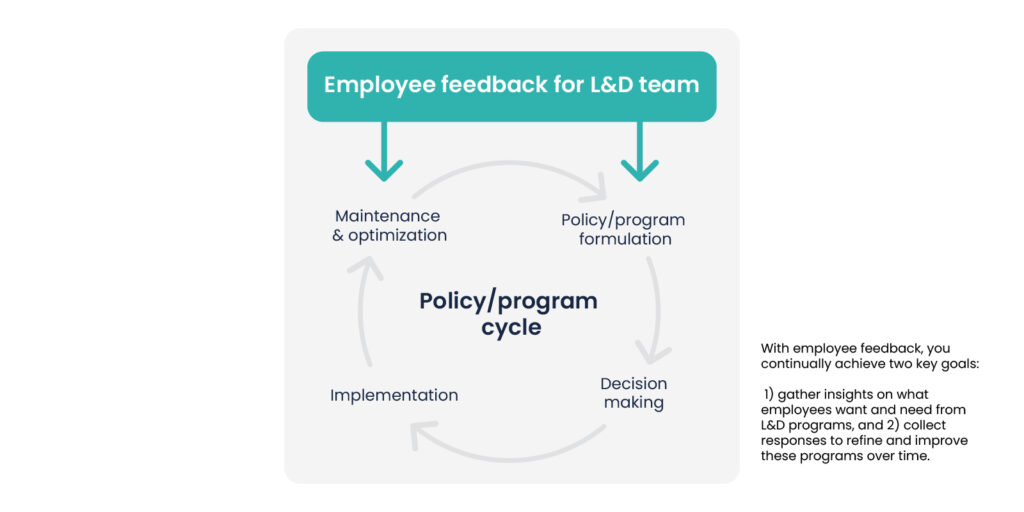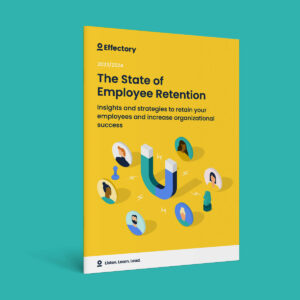At Effectory, we’re proud to partner with some of Europe’s most renowned businesses. One thing we’ve learned is that the best approaches to feedback are often as unique as the organizations themselves. Feedback isn’t a one-size-fits-all. It can be used in countless ways, molded and shaped to the needs of an organization’s unique situation, culture, and people.
3 smart ways to use employee feedback: Part 1 – How to conduct program and policy evaluation surveys

In this blog series, we’ll show you smart ways our customers use employee surveys to make better decisions, improve organization-wide policies and programs, boost management performance, and tackle restructuring challenges more effectively.
What are policy and program evaluation surveys?
Collecting and analyzing employee feedback is essential for creating sustainably successful digital products, such as platforms, apps, or various tools. This feedback is used to develop and improve user experiences, which is key to staying ahead in the competitive markets.
Policy and program evaluation surveys work in a similar way. They are specialized tools that collect feedback from employees about their experience with specific programs and policies, allowing decision-makers to identify what’s working and what needs adjustment.
Zooming in on Learning and Development program evaluation surveys
The challenge with traditional Learning & Development programs
Oftentimes, Learning and Development (L&D) programs are created and evaluated top-down, without continuous, substantial input from the people they are intended to help. This usually results in trainings that don’t align with the actual needs of the workforce, leading to disengagement and ineffective use of resources.
Enhancing retention through L&D initiatives
Investing in L&D programs is a strategic choice for many organizations we work with, mainly because these programs significantly improve retention. When employees participate in relevant and engaging L&D initiatives, they not only become more skilled but also more connected to the organization, and therefore, more likely to stay.
Skipping the step of collecting and analyzing employee insights on L&D programs might be a missed opportunity to enhance their effectiveness and boost retention rates.
The State of Employee Retention
Uncover why employees leave, hidden costs to organizations, and proven retention strategies in our insightful report.
DownloadHow do training program evaluation surveys work?
Effectory’s program evaluation surveys are designed to identify any gaps, issues, or concerns in the L&D programs offered by an organization.
They help our customers better understand what their people need to learn, how they prefer to learn, and their thoughts on existing professional development opportunities.
We found that it’s better to treat the feedback process as a continuous dialogue, rather than a one-time survey. By regularly collecting and analyzing feedback, our customers can update the trainings to match the changing needs and expectations of their employees.
For example, after rolling out an organization-wide Employee Engagement Survey on general Learning and Development sentiments, one of our customers decided to conduct follow-up surveys within the specific group of young talent, which showed lower engagement with existing L&D programs.
These surveys were more focused and included targeted questions such as “My training meets my expectations” or “The trainer gives me constructive feedback.” These types of questions were meant to identify the specific reasons for this group’s dissatisfaction. The surveys also assessed the levels of support they felt they received during their training. Questions were framed as, “How could the organization and/or your manager support you in your career development?”
These targeted follow-up surveys were great for pinpointing specific L&D needs and ensuring that the training programs were effectively addressing those needs, thereby improving their overall impact.
The impact of feedback-driven L&D programs
Organizations who worked with Effectory to set up program evaluation surveys saw the following results:
- A higher participation rate and value of their L&D programs: The insights from the employee feedback guided our customers to create better experiences for their people, resulting in more frequent and better interactions with the L&D offerings. This, in turn, helped customers optimize the return on their investments in L&D programs and maximize the benefits for the most significant workforce transformation challenges.
- Increased training relevance: Feedback helps create training sessions that align more closely with the needs and career goals of employees.
- Increased job performance: Those who have access to better tools and knowledge can do their job better, enhancing overall organizational performance.
- Higher engagement and motivation: When employees see their input shaping the professional development they receive, their connection to the organization strengthens, boosting morale and motivation.
- Reduced employee turnover and recruitment costs: Effective training programs increase job satisfaction, which can reduce turnover rates and the associated costs of recruiting and training new hires. Indeed, investing in retaining your talent through such programs proves cost-effective, embodying the truth that ‘the cheapest hire is the colleague who doesn’t leave.”
This ongoing process of feedback and improvement ensures that Learning & Development programs support the demands of workforce transformation, keep up with employee needs and organizational goals, and stay relevant and impactful.
Zooming in on Policy evaluation surveys
Feedback-driven insights don’t just help organizations improve training programs. They’re also incredibly useful in fine-tuning broader organizational policies that have a direct impact on employees’ daily life.
For example, you can conduct surveys to understand how certain policies affect job satisfaction and effectiveness:
- Workload evaluation: Checking if new policies or initiatives meant to improve work-life balance are actually meeting employee needs or falling short. This direct feedback helps you tweak your interventions to really support your employees.
- Leadership development: Collecting feedback from leaders about their leadership program gives a clear view of how well it’s working for them over time. This feedback identifies any barriers that might stop people from fully embracing the program. It helps you find ways to get more leaders involved and interested, leading to a program that’s more relevant and effective.
- Wellbeing offerings: Evaluating the impact and perceived value of offerings aimed at supporting wellbeing ensures these initiatives are having a positive impact on your workforce.
The emotional and economic costs of overlooking wellbeing in the workplace
Through strategically using surveys to assess and refine L&D and other vital policies, organizations can harness the power of feedback to create better and more personalized employee experiences. They can invest more wisely in their workforce and foster a culture that values ongoing improvement based on real input from employees.

Case study: Refining L&D programs at Effectory with targeted surveys
At Effectory, we recognize the importance of listening to our people. Throughout the year, our L&D team conducts multiple surveys to understand how our employees feel about their training and development opportunities. One notable effort is our annual survey focused on the summer school program. This survey asks participants to share their thoughts on the content and suggest topics they’re interested in exploring further.
In addition to these periodic surveys, we run evaluations after each L&D program. These help us understand the effectiveness of the sessions, especially those we co-develop with external vendors. Feedback is essential here to ensure we’re not only meeting learning objectives but also providing enjoyable and engaging experiences.
For example, feedback from a recent leadership development workshop, aimed at team leads, highlighted a need for adjustments in how trainers interacted with attendees. Participants felt one trainer was too informal, which affected the learning environment. Taking this feedback into account, our L&D team worked with the vendor to adopt a different, more suitable approach in future sessions.
This constant cycle of feedback and adaptation helps us refine our programs and maintain productive relationships with our external partners.
Key takeaways and your next steps
Effective programs and policies are crucial for your organization’s success. In this series, we’ve shown how important it is to incorporate continuous employee feedback into your L&D and policy development to create a responsive and impactful workplace, which leads to an exceptional employee experience. Check out Part 2, where we will explore how to use targeted surveys to improve management strategies and decision-making.
Read part 2 of the series here.
3 smart ways to use employee feedback series:
- Part 1: How to conduct program and policy evaluation surveys
- Part 2: How to target specific teams or groups with surveys
- Part 3: How to manage organizational change through surveys
Book a free demo. See our solutions in action.
Effectory is Europe’s Leading provider of Employee Listening Solutions. Schedule a product demo and discover how to enhance your employees’ engagement.
Demo request
